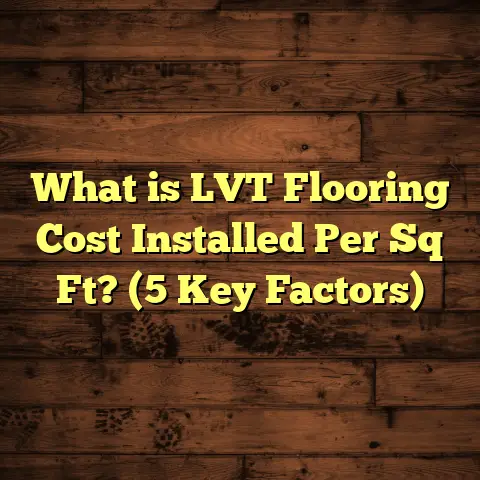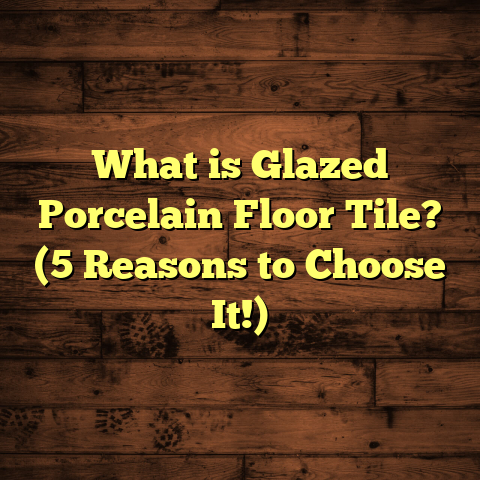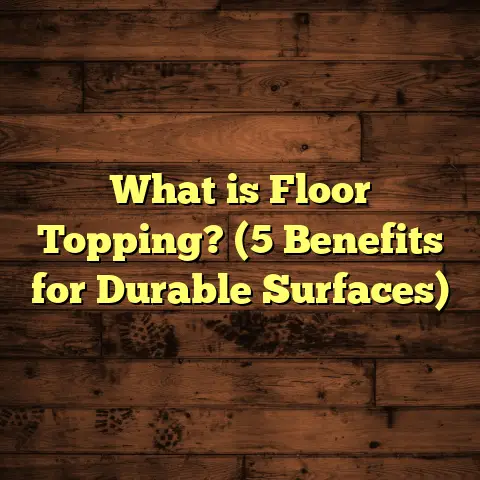What is the Average Price Per Square Foot for Flooring? (5 Key Factors to Consider)
Have you ever thought about how much it really costs to install new flooring? Maybe you’re dreaming about fresh hardwood floors or stylish tiles, but the numbers you hear seem all over the place. You might be wondering: what’s the average price per square foot for flooring? How do I even begin to budget for something that can vary so much? As someone who’s worked in flooring for years, plus done a few home projects myself, I get it. It’s confusing, and sometimes it feels like there’s a secret code to pricing.
So let’s sit down and chat about this. I’ll share what I’ve learned from years on the job, plus stories from my own installations and clients, and break down the real numbers behind flooring costs. By the time you finish reading, you’ll have a clear picture of what to expect and how to plan your budget smartly.
What is the Average Price Per Square Foot for Flooring?
Let’s start with the basics: the price per square foot for flooring tells you how much it costs to cover one square foot of your floor with a specific material, including installation. This number is crucial because it helps you estimate the total cost of your project by multiplying it by your floor’s total square footage.
The challenge is that this number changes a lot depending on what kind of flooring you want, where you live, how complicated the installation is, and other factors. For example:
- Basic vinyl flooring might cost as little as $1.50 per square foot installed.
- Mid-range laminate could be closer to $3-$5 per square foot.
- Hardwood floors could run anywhere from $7 to $20 per square foot installed.
- High-end natural stone tiles might be $15 or more per square foot.
I remember when I first started working in flooring, I was surprised at how wide these ranges can be. A client in a small town might pay half what someone in a big city pays for the same type of floor. Installation skill level also makes a big difference—some floors require more time, special tools, or prep work.
Breaking Down Price Per Square Foot
Here’s what usually goes into calculating that average price:
- Material Cost: This is the price of the actual flooring product, whether it’s wood planks, tiles, or carpet.
- Labor Cost: The amount paid to professional installers who prepare the floor and lay everything down.
- Preparation Work: Sometimes you need to remove old flooring or fix underlying subfloors before installing new materials.
- Additional Materials: Things like underlayment, adhesives, grout, nails, or sealants can add to overall cost.
- Waste Factor: Flooring materials often come in set sizes or boxes. You usually buy extra to cover cuts or mistakes.
When I talk about “average” price per square foot, it’s really an estimate based on these components combined.
5 Key Factors That Affect Flooring Price Per Square Foot
Now I want to dig deeper into five major factors that shape your final cost. These are things I’ve seen over and over impact budgets and timelines on real projects.
1. Type of Flooring Material
This is the biggest factor by far. The type of material you pick sets a baseline for price.
Vinyl Flooring — Budget-Friendly and Durable
Vinyl flooring has improved a lot in recent years. Luxury vinyl planks (LVP) mimic hardwood look quite well at a fraction of the cost. The prices for vinyl usually start around $0.75 per square foot for basic sheets and can go up to $3 or more for premium planks.
Installation is fairly straightforward and quick, so labor costs tend to be low—around $1 to $3 per square foot. I helped a client redo their kitchen with vinyl plank flooring last year. Their total price was about $3 per square foot installed, which was perfect for their tight budget.
Vinyl is waterproof and scratch-resistant but can feel less “authentic” than wood or stone underfoot.
Laminate Flooring — Affordable and Attractive
Laminate flooring offers many styles that resemble wood or tile at lower prices. Laminate boards usually range from $1 to $3 per square foot for materials.
Installation costs are similar to vinyl since it’s often a floating floor system that doesn’t require glue or nails. Overall installed prices fall roughly between $2 and $6 per square foot.
I once helped a family install laminate throughout their basement. They wanted a wood look but couldn’t afford hardwood. The project came in at about $4 per square foot installed and transformed the space beautifully.
Hardwood Flooring — Classic and Timeless
Hardwood floors are often the dream choice but come with higher prices. Solid hardwood prices vary widely depending on species:
- Oak: $3 to $8 per sq ft material cost
- Maple: $4 to $9
- Exotic woods like Brazilian cherry or walnut can be $8 to $15 or more
Labor is also more expensive due to the precision needed—expect $4 to $8 per sq ft for installation.
In total, hardwood floors usually run from $7 up to $20+ per square foot installed depending on your choices.
I remember one project in Chicago where exotic mahogany was installed in a large living room. The materials alone were about $12 per square foot, and labor pushed total costs near $22 per sq ft.
Engineered Wood Flooring — A Solid Middle Ground
Engineered wood offers real wood layers over plywood backing. This means it’s often cheaper than solid hardwood but still looks authentic.
Materials cost between $2 and $7 per sq ft; installation generally runs from $3 to $6 per sq ft.
A client of mine in Austin picked engineered oak for their condo floors and got great looks for about $9 total per square foot installed.
Tile Flooring — Durable But Varies Widely
Tile prices depend heavily on type:
- Ceramic tile: $2 to $7 material cost
- Porcelain tile: $4 to $10
- Natural stone (marble, granite): $7 to $20+
Installation labor is usually higher than wood or vinyl—anywhere from $3 to $10 per sq ft—because tiles need precise setting and grouting.
One bathroom remodel I did used Italian marble tiles that cost $18 per sq ft just for materials; installation added another $8.
Carpet — Soft Underfoot But With Lower Price Range
Carpet materials range from inexpensive synthetics ($1 per sq ft) up to luxury wool blends ($5+).
Installation labor is usually between $1 and $4 per sq ft depending on complexity.
For example, a renter’s apartment carpet replacement I did recently was about $3 per sq ft installed using mid-range nylon carpet.
2. Labor Costs by Location
Where you live has a huge impact on labor charges for flooring installation.
In cities with high costs of living like New York, San Francisco, or Boston, labor rates tend to be steep—often between $6 and $12 per square foot for hardwood or tile projects.
On the other hand, smaller towns or rural areas may see rates closer to $2-$5.
I’ve personally worked in both environments. In Denver, labor costs were reasonable at about $5 per sq ft for hardwood installation. But when I helped a client install floors in Manhattan, labor alone was closer to $10 per sq ft because of union wages and permit requirements.
Besides geography, labor costs also depend on installer skill level. Certified specialists charging premium rates often deliver better craftsmanship but at higher prices.
3. Subfloor Preparation and Removal
You can’t ignore what’s under your current floor when budgeting.
Removing old flooring varies widely:
- Carpet removal: Usually around $0.50-$2 per sq ft
- Tile removal: More difficult; often $2-$5 or more
- Hardwood removal: Can be expensive if nailed down firmly
If your subfloor is damaged or uneven (which happens more than you’d think), expect additional fees:
- Minor leveling: $1-$3 per sq ft
- Major repairs or replacement: Upwards of $5+ per sq ft
In one project with water damage under old hardwood, replacing plywood subfloor sections added nearly $6 extra per square foot before new floor installation.
Ignoring these prep costs can lead to surprises later on or poor final results if shortcuts are taken.
4. Complexity of Installation
How tricky your installation is impacts both time and cost dramatically.
Some floors go down quickly:
- Floating laminate or vinyl plank floors can be done in a day for an average room.
Others take more effort:
- Nail-down hardwood requires precise placement.
- Tile work with patterns like herringbone or mosaic takes hours longer.
- Installing stairs or working around built-ins adds complexity.
I recall installing herringbone oak floors in a client’s living room that took twice as long as regular plank layout due to cutting angles and fitting around fireplaces. Labor costs were about 50% higher for that reason.
5. Timeframe and Seasonality
If you need floors installed ASAP, expect higher prices due to rush scheduling fees.
Many contractors are busiest from spring through early fall when homeowners prefer remodeling projects done in warmer weather.
Scheduling your project during off-season months (late fall/winter) often helps snag better deals or quicker start dates.
Once I had a client request flooring just two weeks before Thanksgiving; we had to bump their job up and charged them roughly 15% more because of tight timing.
Crunching Numbers: What Does This Look Like For Your Project?
Let me share some detailed examples based on real jobs I’ve handled recently along with national averages for 2024:
| Material | Material Cost | Labor Cost | Prep/Removal Cost | Typical Total Cost |
|---|---|---|---|---|
| Vinyl Plank | $1 – 2 | $1 – 3 | Minimal ($0-$1) | $2 – 6 / sq ft |
| Laminate | $1 – 3 | $1 – 3 | Moderate ($0-$2) | $2 – 8 / sq ft |
| Hardwood (Oak) | $4 – 8 | $4 – 8 | Moderate/High ($2-$5) | $10 – 20 / sq ft |
| Engineered Wood | $2 – 7 | $3 – 6 | Moderate ($1-$3) | $6 – 13 / sq ft |
| Tile (Ceramic) | $2 – 7 | $3 – 7 | Moderate ($2-$4) | $7 – 18 / sq ft |
| Tile (Natural Stone) | $7 – 15 | $5 – 10 | High ($3-$6) | $15 – 30+ / sq ft |
| Carpet | $1 – 4 | $1 – 4 | Low ($0-$1) | $2 – 9 / sq ft |
For example:
- A typical 1,200 sq ft vinyl plank installation might range from $2,400 to $7,200 all-in.
- Hardwood floors on that same size could easily hit $12,000 to $24,000 depending on wood species and labor complexity.
- Tile bathrooms with natural stone could run $5,000+ just for 300 sq feet including prep work.
How I Help Clients Navigate These Numbers
I’ve worked with homeowners who come with wildly different budgets and expectations. Some want high-end materials but have limited funds; others want durable floors that won’t break the bank but still look nice.
One couple I worked with wanted hardwood throughout their house but only had about $10k budget for floors including everything. We talked through material options and settled on engineered oak that met their style but kept costs manageable around $9/sq ft installed.
Another client had a tight budget but wanted something waterproof for their basement playroom. We chose vinyl plank flooring that looked great and stayed under $5/sq ft installed including removal of old carpet.
My Personal Experience Installing Floors
I’ve installed floors in my own homes multiple times—and sometimes those projects taught me lessons about costs firsthand.
In one house renovation back in 2017:
- I tore out old carpet covering roughly 800 sq feet (cost about $800).
- Chose mid-grade laminate at around $2/sq ft ($1600 materials).
- Paid a local installer about $3/sq ft ($2400 labor).
Total came close to $4,800, which felt like a lot until I realized how much work went into prep and clean-up too.
In contrast, when I helped my parents install vinyl plank in their kitchen recently:
- Materials cost was about $900 for 300 sq feet.
- Labor was roughly equal at around another $900.
Total was about $1,800, showing how different material choice affects pricing dramatically even within same home size scale.
Tools That Can Help You Estimate Costs Accurately
FloorTally is one tool I recommend often because it lets you plug in your room size,
select materials,
choose local labor rates,
and factor waste percentage,
giving you a detailed estimate tailored to your location and preferences.
It saves time hunting down individual quotes and avoids surprises by giving clear projections upfront.
Plus it supports many flooring types from vinyl up through natural stone tile with customizable options so you can compare costs side-by-side easily.
Common Myths About Flooring Costs
I hear some things repeated a lot that aren’t quite true:
Myth #1: Hardwood floors always cost twice as much as laminate
Not necessarily true! While hardwood tends to be pricier,
some engineered wood products come close in price to high-end laminates,
especially when installation complexity is factored in.
Myth #2: Vinyl floors are cheap junk
Actually,
modern luxury vinyl planks can be quite durable,
look very realistic,
and offer waterproof qualities not found in hardwood or laminate,
all at affordable prices.
Myth #3: Installation is cheap if you DIY
DIY can save money but comes with risks—mistakes made during installation can ruin expensive materials or reduce lifespan,
which might end up costing more in repairs or replacements later.
How Size Affects Price Per Square Foot
You might wonder if bigger rooms mean lower price per square foot because of economies of scale?
Sometimes yes—but not always!
Larger projects can reduce overhead costs like travel time or setup fees,
but if your space has lots of angles,
stairs,
or requires multiple rooms,
those complexities can add up quickly regardless of size.
Final Thoughts From Someone Who’s Done It All
Over the years,
installing floors in dozens of homes,
working with many clients,
and doing my own projects has taught me this:
Pricing flooring isn’t just about picking a number off a list;
it’s about understanding your needs,
your style,
your budget constraints,
and your home’s unique conditions.
Take your time researching options,
get multiple quotes,
and consider tools like FloorTally for realistic budgeting before making decisions.
If you keep these factors in mind,
you’ll avoid surprises,
get great value for your money,
and enjoy beautiful new floors for years to come.
If you have specific questions about your flooring needs or want help estimating costs based on your location and preferences,
just let me know—I’m happy to share what works best based on real experience!
End of Article





